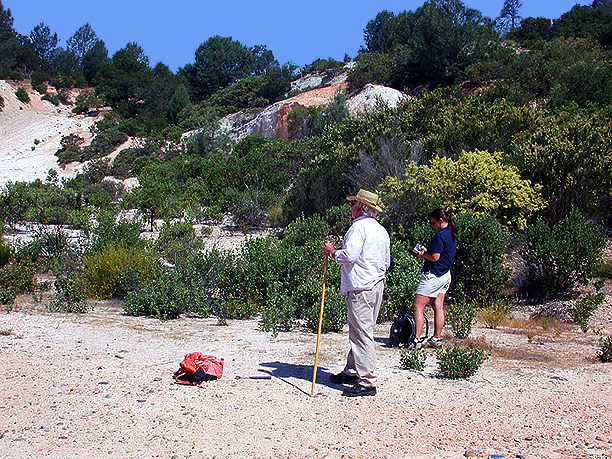
|
Left to right: Paleobotanist Howard Schorn, retired Collections Manager Of Fossil Plants at the University California Museum Of Paleontology in Berkeley, and geologist Robinson Cecil observe significant outcrops of the Middle Eocene Ione Formation in the Ione Basin, western foothills of the Sierra Nevada, Amador County, California. Howard had invited me on the field trip to help Robinson, then a geology student at the University Of Arizona in Tucson, familiarize herself with some leaf-bearing Eocene geologic sections she planned to measure for a National Science Foundation project (co-led by the late paleobotanist Dr. Jack A. Wolfe) to determine the paleoelevations and paleoclimate of the Sierra Nevada during Eocene geologic times, roughly 50 to 45 million years ago. Image taken on June 3, 2003. In late May, 2003, paleobotanist Howard Schorn sent an email my way--geologist Robinson Cecil, then a student at the University Of Arizona in Tucson, was flying to California to familiarize herself with several leaf-bearing Eocene geologic sections she planned to measure for the scientific project Howard and others were involved in--a project funded by the National Science Foundation to study the numerous Eocene fossil floras of the Sierra Nevada district, in order, eventually, to determine the paleoelevations and paleoclimate of the ancestral Sierra Nevada during Eocene geologic times, approximately 50 to 45 million years ago. Howard wanted Robinson, first-off, to examine at least a couple of the leaf-yielding sections in the Middle Eocene Ione Formation of the Ione Basin; after the visit to the Ione Basin, he planned to drive her higher up the western slopes of the Sierra Nevada, in the neighborhood of Grass Valley/Nevada City, so that she might examine several of the abandoned open pit hydraulic gold mines (all lie on private property, presently inaccessible to unauthorized explorations), where gold seekers of the mid to late 1800s laid bare mile after mile of the northern Mother Lode district, using vast quantities of high-pressure jets of water to tear away entire mountainsides of the so-called early to early-mid Eocene auriferous, or gold bearing gravels. Interbedded with the coarser pebble to boulder-sized gold-bearing gravels there are minor interbeds of chocolate-colored, fine-grained clays and shales that yield one of the greatest concentrations of Eocene plants in the world. This is the classic, world-famous Chalk Bluffs Flora, which yields to paleobotanists over 70 species of ancient plant remains--mostly leaves preserved in a stunning, magnificent state of preservation. Robinson would eventually measure several geologic sections at the abandoned hydraulic pits. In preparation for the visit, Howard graciously reserved rooms for all of us at a motel in Jackson, the County Seat of Amador County, California. After Howard picked Robinson up at the airport, we all met up at the motel in Jackson during the early evening of June 2, 2003. Over dinner at Dennys restaurant in Jackson, Howard and I agreed that we should take Robinson to two of the major fossil localities in the Middle Eocene Ione Formation--the so-called Discovery Site, where I had first found fossil leaves in the Ione Basin back on July 21, 1991, and classic Lygodium Gulch, which had been named for the rather common to abundant occurrence of a fossil climbing fern, Lygodium kaulfussi, whose closest modern counterpart is Lygodium palmatum, native to Mississippi, Alabama and Georgia north to New England; Lygodium Gulch produced the only fossil climbing fern specimens west of the Rocky Mountains to find their way into a museum. Please note: All fossil localities in the Ione Formation of Amador County, California, presently occur on private property; explicit permission from the land owners must be secured before collecting fossils there. |